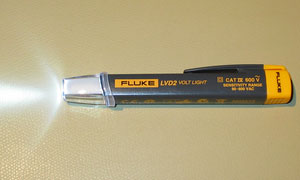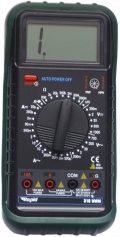Trace
How to trace the wiring of a mains circuit.
How to
There are several possible ways.
See what's live
Switch all circuits off bar the one you want to trace, and test which lighting points or sockets are still live. If you're only looking for lighting points and sockets, this can be done by plugging light bulbs or portable lights in.
If you're also looking for junction boxes or loose cable ends, you can either use a live wire detector, or if you don't have one you'd need to access the live wires and use a multimeter on the voltage range. The latter means live working, which is not recommended, and doubly not recommended if you need to read this article.
Fluke Voltalert and Greenbook live wire detector are both live wire detectors.
Multimeter
A Multimeter and a long wire can be used. Power must be off on /all/ circuits to use this, then you can trace where the live wire goes using the low resistance range on any multimeter. Check the resistance from L to N on the circuit first, it needs to be not low. You may need to remove or switch off loads on the circuit to get this.
You need to trace the live wire, not neutral or earth wires, as the latter are normally connected to those on other circuits even when the MCBs in the CU are off or the fusebox fuses removed.
Note that turning the main CU switch off doesn't electrically separate the circuits, all MCBs still need to be off, or all fuses pulled.
Note that if any loads are left switched on on the circuit under test, then continuity will be found too other circuits in the house too, but with a higher resistance reading.
Signal generator
Option D is a signal generator and a sniffer. Feed an audio or rf signal down the live wire, then use the sniffer to locate where it runs.
- The MCB of the circuit being tested must be off before connecting the signal generator.
- All loads on the circuit under test should be switched off to avoid the signal getting onto other circuits via the neutrals.
- This approach is well suited to signal voltage wiring
Neon screwdrivers
They produce both false positives and false negatives, making them a safety liability. They're are not recommended. See Neon screwdriver
Which is best
- If you don't need to trace junction boxes or loose cable ends, the first option with no live working
- If you also need to trace junction boxes or loose cable ends, either option 1 with a live wire detector or the 2nd option with a multimeter.
Sourcing equipment
A live wire sniffing function is found on some stud detectors. Or with electronic skills they're simple to make from a few bits.
You can hire Fluke cable tracers, about £50-80, or buy for about £290.
Commercial signal generators are very overspecified for cable tracing, just a simple oscillator is needed. This can be made from a cmos invertor, opamp or comparator, with a resistor on the output so it doesn't mind being shorted. 5kHz works, but its far from critical.
Safety
Live working should be avoided. There are safer options.
If you're working on an unfamiliar property and wish to use a method requiring that all power be off, check that everything is dead before proceeding, in case there's a 2nd CU somewhere else still supplying power.
There are some situations in which even apparently dead wiring can become live. There are also wiring errors occasionally found in which the output of more than one fuse or MCB gets connected, resulting in a switched off circuit still being live. So if you're going to get access to the wires (rather than eg using a lightbulb to test), the main switch on the fusebox should be turned off.

